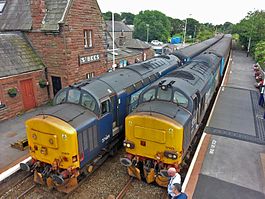Whitehaven Junction Railway
| Cumbrian Coast line | |
|---|---|

Class 37s working scheduled service trains on the Cumbrian Coast line in 2015
|
|
| Overview | |
| Type | Heavy rail |
| System | National Rail |
| Status | Operational |
| Locale | Cumbria, North West England |
| Termini |
Barrow-in-Furness Carlisle |
| Stations | 26 |
| Services | 1 |
| Operation | |
| Opened | 1844 |
| Owner | Network Rail |
| Operator(s) | Northern |
| Rolling stock | |
| Technical | |
| Line length | 85.50 mi (137.60 km) |
| Number of tracks | Mainly double-tracked, three sections of single track. |
| Track gauge | 4 ft 8 1⁄2 in (1,435 mm) |
The Cumbrian Coast line is a rail route in North West England, running from Carlisle to Barrow-in-Furness via Workington and Whitehaven. The line forms part of Network Rail route NW 4033, which continues (as the Furness line) via Ulverston and Grange-over-Sands to Carnforth, where it connects with the West Coast Main Line.
George Stephenson favoured, and carried out preliminary surveys for, a scheme to link England and Scotland by a railway running along the coast between Lancaster and Carlisle, but this 'Grand Caledonian Junction Railway' was never built, the direct route over Shap being preferred. Consequently, the line along the Cumbrian coast is the result of piecemeal railway building (largely to serve local needs) by a number of different companies:
Promoted to link with Newcastle and Carlisle Railway to give "one complete and continuous line of communication from the German Ocean to the Irish Sea" and to open up the northern (inland) portion of West Cumbrian coalfield. Act of Parliament obtained 1837; first section – Maryport to Arkleby (just short of Aspatria) – opened 1840: line Maryport–Carlisle fully opened 1845. Originally laid single; doubled throughout (to accommodate heavy and profitable mineral traffic) by 1861. Remained independent (and highly profitable) until grouping.
Maryport to Whitehaven (Bransty) (leased by London and North Western Railway 1865; amalgamated with LNWR 1866)
...
Wikipedia
